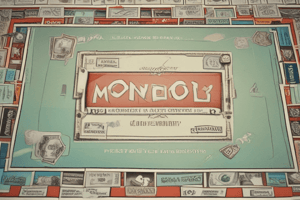Podcast
Questions and Answers
Which type of merger involves two competing companies joining forces?
Which type of merger involves two competing companies joining forces?
- Conglomerate Merger
- Horizontal Merger (correct)
- Bid-Rigging
- Vertical Merger
Predatory pricing is a legal practice in an oligopolistic market.
Predatory pricing is a legal practice in an oligopolistic market.
False (B)
What is it called when a dominant company uses its market power to unfairly affect another market?
What is it called when a dominant company uses its market power to unfairly affect another market?
Abuse of Dominant Position
A __________ merger is when a company purchases another business that operates in a different industry.
A __________ merger is when a company purchases another business that operates in a different industry.
Match the terms with their definitions:
Match the terms with their definitions:
What characterizes the demand curve for a monopolist?
What characterizes the demand curve for a monopolist?
The demand curve in monopolistic competition is steeper than that of a monopoly.
The demand curve in monopolistic competition is steeper than that of a monopoly.
What happens when one firm in an oligopoly raises its price?
What happens when one firm in an oligopoly raises its price?
The oligopolistic demand curve is characterized by _________ due to mutual interdependence.
The oligopolistic demand curve is characterized by _________ due to mutual interdependence.
Match the market structure with its demand characteristics:
Match the market structure with its demand characteristics:
Which of the following statements about monopolistic competition is true?
Which of the following statements about monopolistic competition is true?
In an oligopoly, the demand is always perfectly elastic.
In an oligopoly, the demand is always perfectly elastic.
What is mutual interdependence in the context of oligopolies?
What is mutual interdependence in the context of oligopolies?
What is price leadership in the context of cooperative oligopolies?
What is price leadership in the context of cooperative oligopolies?
Collusion among companies is a legal practice in cooperative oligopolies.
Collusion among companies is a legal practice in cooperative oligopolies.
What is a cartel in the context of oligopolies?
What is a cartel in the context of oligopolies?
In oligopolistic competition, the point of profit maximization is found where marginal revenue equals ______.
In oligopolistic competition, the point of profit maximization is found where marginal revenue equals ______.
Match the following terms with their definitions:
Match the following terms with their definitions:
Which of the following statements about the kinked demand curve is true?
Which of the following statements about the kinked demand curve is true?
In the Prisoner’s Dilemma, both players have the best collective outcome if they both cooperate.
In the Prisoner’s Dilemma, both players have the best collective outcome if they both cooperate.
What does game theory study in relation to oligopolistic firms?
What does game theory study in relation to oligopolistic firms?
An example of collusion can be seen in the simultaneous ______ of bread prices by major retailers.
An example of collusion can be seen in the simultaneous ______ of bread prices by major retailers.
What do oligopolists use to determine their pricing strategy?
What do oligopolists use to determine their pricing strategy?
What is the best possible outcome for two companies involved in price fixing?
What is the best possible outcome for two companies involved in price fixing?
The least optimal option for both companies is to cheat.
The least optimal option for both companies is to cheat.
What happens if one company cheats while the other does not?
What happens if one company cheats while the other does not?
Under anti-combines legislation, proving guilt is based on the _____ that someone probably did it.
Under anti-combines legislation, proving guilt is based on the _____ that someone probably did it.
Match the following outcomes with their corresponding scenarios in the prisoner's dilemma:
Match the following outcomes with their corresponding scenarios in the prisoner's dilemma:
What consequence typically occurs when both companies in an oligopoly choose to cheat?
What consequence typically occurs when both companies in an oligopoly choose to cheat?
Competition Acts only punish companies that are directly found guilty of cheating.
Competition Acts only punish companies that are directly found guilty of cheating.
Describe the relationship between trust and outcomes in the context of the prisoner's dilemma.
Describe the relationship between trust and outcomes in the context of the prisoner's dilemma.
The example of OJ Simpson illustrates the difference between criminal and _____ liability.
The example of OJ Simpson illustrates the difference between criminal and _____ liability.
What drives companies in an oligopoly to choose a less optimal decision?
What drives companies in an oligopoly to choose a less optimal decision?
Flashcards
Monopolist Demand
Monopolist Demand
The demand curve for a monopolist is the same as the market demand curve. It is downward sloping and inelastic, meaning changes in price have a small impact on quantity demanded.
Monopolistic Competitor's Demand
Monopolistic Competitor's Demand
The demand curve for a monopolistic competitor is flatter than a monopolist's, due to the existence of substitutes. It is elastic, meaning changes in price have a significant impact on quantity demanded.
Mutual Interdependence in Oligopolies
Mutual Interdependence in Oligopolies
Oligopolies are characterized by mutual interdependence, meaning each firm's actions affect and are affected by the actions of its competitors.
Price Increase in Oligopoly
Price Increase in Oligopoly
Signup and view all the flashcards
Price Decrease in Oligopoly
Price Decrease in Oligopoly
Signup and view all the flashcards
Kinked Demand Curve in Oligopoly
Kinked Demand Curve in Oligopoly
Signup and view all the flashcards
Cooperation in Oligopolies
Cooperation in Oligopolies
Signup and view all the flashcards
Competition in Oligopolies
Competition in Oligopolies
Signup and view all the flashcards
Bid-Rigging
Bid-Rigging
Signup and view all the flashcards
Predatory Pricing
Predatory Pricing
Signup and view all the flashcards
Abuse of Dominant Position
Abuse of Dominant Position
Signup and view all the flashcards
Mergers
Mergers
Signup and view all the flashcards
Horizontal Merger
Horizontal Merger
Signup and view all the flashcards
Price Leadership
Price Leadership
Signup and view all the flashcards
Price Fixing (Collusion)
Price Fixing (Collusion)
Signup and view all the flashcards
Cartel
Cartel
Signup and view all the flashcards
Kinked Demand Curve
Kinked Demand Curve
Signup and view all the flashcards
Revenue Condition for Oligopolies
Revenue Condition for Oligopolies
Signup and view all the flashcards
Profit Maximization for an Oligopoly
Profit Maximization for an Oligopoly
Signup and view all the flashcards
Game Theory
Game Theory
Signup and view all the flashcards
Prisoner's Dilemma
Prisoner's Dilemma
Signup and view all the flashcards
Mutual Non-Confession
Mutual Non-Confession
Signup and view all the flashcards
One Confesses, One Stays Silent
One Confesses, One Stays Silent
Signup and view all the flashcards
Price Fixing
Price Fixing
Signup and view all the flashcards
Collusion
Collusion
Signup and view all the flashcards
Anti-Combines Legislation
Anti-Combines Legislation
Signup and view all the flashcards
Preponderance of the Evidence
Preponderance of the Evidence
Signup and view all the flashcards
Civil Case
Civil Case
Signup and view all the flashcards
Criminal Case
Criminal Case
Signup and view all the flashcards
Beyond a Reasonable Doubt
Beyond a Reasonable Doubt
Signup and view all the flashcards
Monopoly
Monopoly
Signup and view all the flashcards
Oligopoly
Oligopoly
Signup and view all the flashcards
Study Notes
Monopoly & Monopolistic Competition
-
Monopolist Demand: The demand curve is the same as the market demand curve and is downward sloping. It's inelastic.
-
Monopolistic Competition: The demand curve is flatter than a monopolist's because of substitutes. It's elastic.
Monopolistic Competitor's Demand
-
Key difference: The demand curve is flatter due to readily available substitutes, unlike a monopoly.
-
To graph a monopolistic competitor's demand curve:
- Find where marginal revenue (MR) meets marginal cost (MC) and mark a point.
- Locate the quantity on the demand curve from the vertical line drawn from the MR/MC point.
- Draw a horizontal line to the y-axis to determine average total cost (ATC).
- You can calculate profit by either finding the area of the top rectangle of the profit box (or revenue box) or using the formula P=TR-TC.
Oligopolist's Demand
- Mutual Interdependence: Oligopolies are characterized by mutual interdependence between firms. One firm's actions affect others.
- Elastic or Inelastic Demand: The demand curve can be either elastic or inelastic, depending on the reaction of competitors to price changes. If one firm raises the price, others may not follow, causing significant losses in customers (elastic). If one firm lowers the price, competitors may follow, limiting price gains (inelastic).
Cooperative Oligopolies
- Price leadership: One company sets the price, and others follow suit. This is illegal.
- Collusion/Price fixing: Companies explicitly agree on prices to maximize their profits by reducing output. Examples: discussing terms to raise prices, price fixing in a specific industry (like bread pricing between companies).
- Cartels: Firms agree to limit output and keep prices high; e.g., OPEC limiting oil supply to influence price.
Oligopolistic Competition
-
Revenue Condition for Oligopolist: The business' marginal revenue curve has two distinct parts that are below the kinked demand curve.
-
Profit maximization in oligopoly: Is the same as any other market; quantity is found where marginal revenue equals marginal cost. Price is determined by the business' kinked demand curve.
-
Game theory is a study of interdependent players achieving their goals in a market. It studies interdependent behaviour in markets, particularly oligopolies.
Prisoner's Dilemma in Oligopoly
- Self-interest: Each firm's most profitable option is to cheat when others don't. However, the best option for all firms is cooperation.
- No Trust: The best course of action in an oligopoly is to never trust the other firms to act in your interest.
- Cheating vs Cooperation: Firms consider self-interest when engaging in price fixing. Profitability often outweighs ethical considerations.
Anti-Combines Legislation
-
These laws prevent industrial concentration.
-
Prosecutions need to prove a firm's wrongdoing, not just that they are powerful.
Criminal and Civil Offenses Under Competition Acts
- Conspiracy: Companies collude to fix prices or rig bids.
- Bid-rigging, predatory pricing, abuse of dominant position: Other anti-competitive behaviours.
- Mergers: These can harm competition. Horizontal mergers hurt most, while vertical mergers hurt less. Conglomerate mergers hurt least compared to the others. Mergers are heavily regulated.
Studying That Suits You
Use AI to generate personalized quizzes and flashcards to suit your learning preferences.





